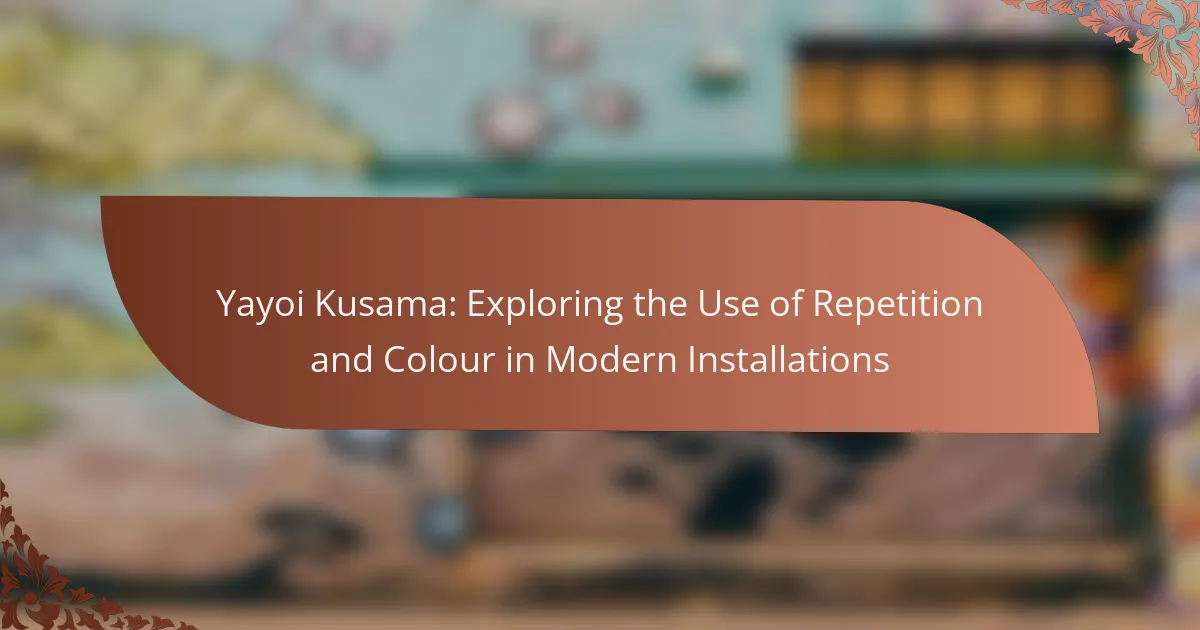Yayoi Kusama’s installations captivate audiences through the innovative use of repetition and vibrant colour. This article explores how her repetitive patterns symbolize infinity and evoke emotional responses. It examines her signature polka dots, the immersive environments she creates, and the cultural impact of her work. Additionally, it addresses the viewer experience and the psychological themes underlying her art.
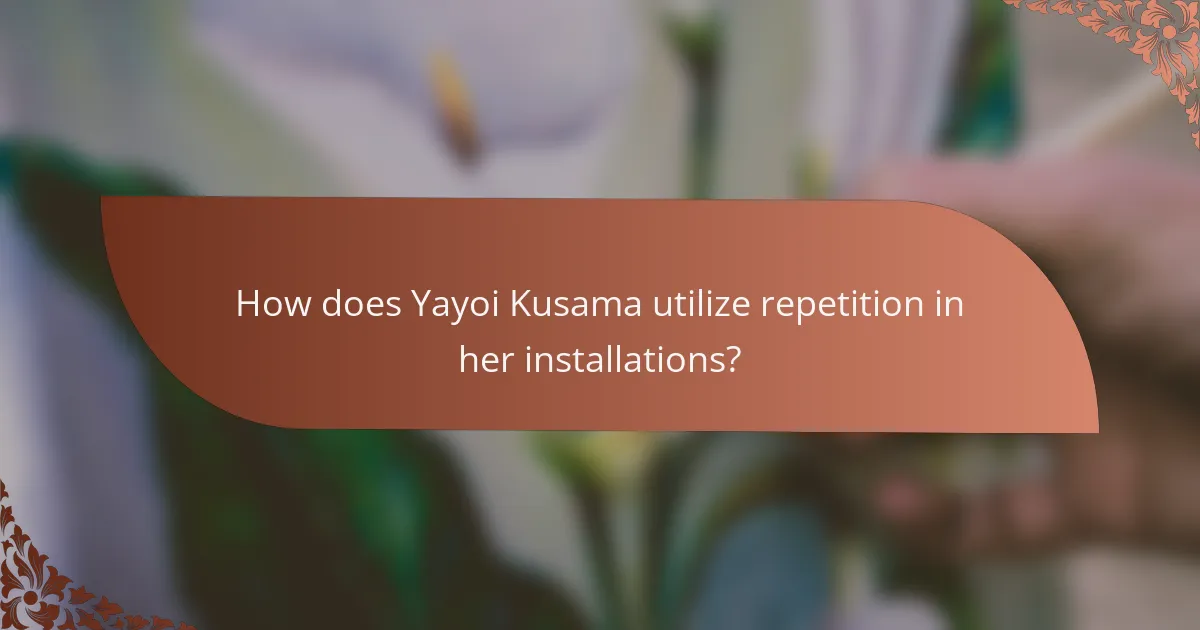
How does Yayoi Kusama utilize repetition in her installations?
Yayoi Kusama employs repetition to create immersive experiences that challenge perception and evoke emotions. Her installations often feature repetitive patterns and motifs, such as polka dots and infinity nets, which symbolize her psychological struggles and connection to the universe. This technique enhances the viewer’s engagement and invites exploration of the artwork’s themes. Through repetition, Kusama transforms spaces into environments that blur the lines between art and reality, fostering a sense of infinity and continuity.
What are the psychological effects of repetition in Kusama’s art?
Repetition in Yayoi Kusama’s art creates profound psychological effects, including a sense of infinity and self-obliteration. This technique engages viewers, prompting introspection and emotional resonance. The immersive quality of repeated patterns can evoke feelings of tranquility or anxiety, depending on the viewer’s perspective. Kusama’s use of colour further enhances these effects, creating vibrant experiences that challenge perception and provoke thought.
Which installation examples showcase the use of repetition?
Yayoi Kusama’s installations frequently showcase repetition through her iconic polka dots and mirrored environments. Notable examples include “Infinity Mirror Rooms,” where endless reflections create an immersive experience, and “The Obliteration Room,” transforming a white space into a vibrant explosion of colour through visitor interaction. These installations highlight her unique approach to repetition, emphasizing themes of infinity and self-obliteration.
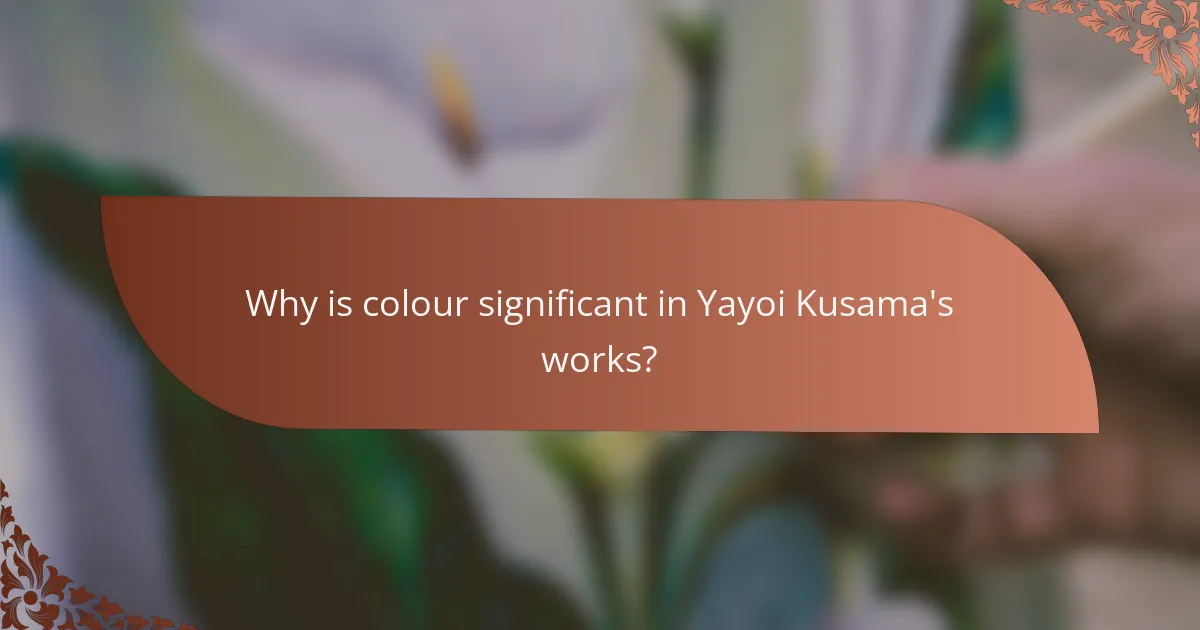
Why is colour significant in Yayoi Kusama’s works?
Colour is significant in Yayoi Kusama’s works as it evokes emotional responses and enhances the immersive experience. Her use of vibrant hues, often in polka dots, creates a sense of unity and repetition, reflecting her unique perspective on infinity and obsession. Each colour choice conveys specific meanings, influencing viewer perception and engagement. Kusama’s signature palette transforms installations into dynamic environments, inviting exploration and introspection.
How does colour influence the viewer’s experience?
Colour significantly influences viewer experience by evoking emotions and shaping perceptions. Yayoi Kusama’s use of vibrant colours in her installations creates immersive environments that engage audiences. Bright colours can stimulate excitement, while softer tones may evoke calmness. The repetition of patterns enhances this effect, drawing viewers into a deeper interaction with the artwork. By combining colour and repetition, Kusama transforms spaces, making the viewer’s experience both unique and memorable.
What colour palettes are commonly used by Kusama?
Yayoi Kusama commonly uses vibrant colour palettes featuring bold reds, yellows, blues, and blacks. These colours enhance her signature polka dot patterns and immersive installations. The use of repetition alongside these colours creates a visually striking experience that captivates viewers. Kusama’s unique approach to colour reflects her psychological themes and personal experiences.
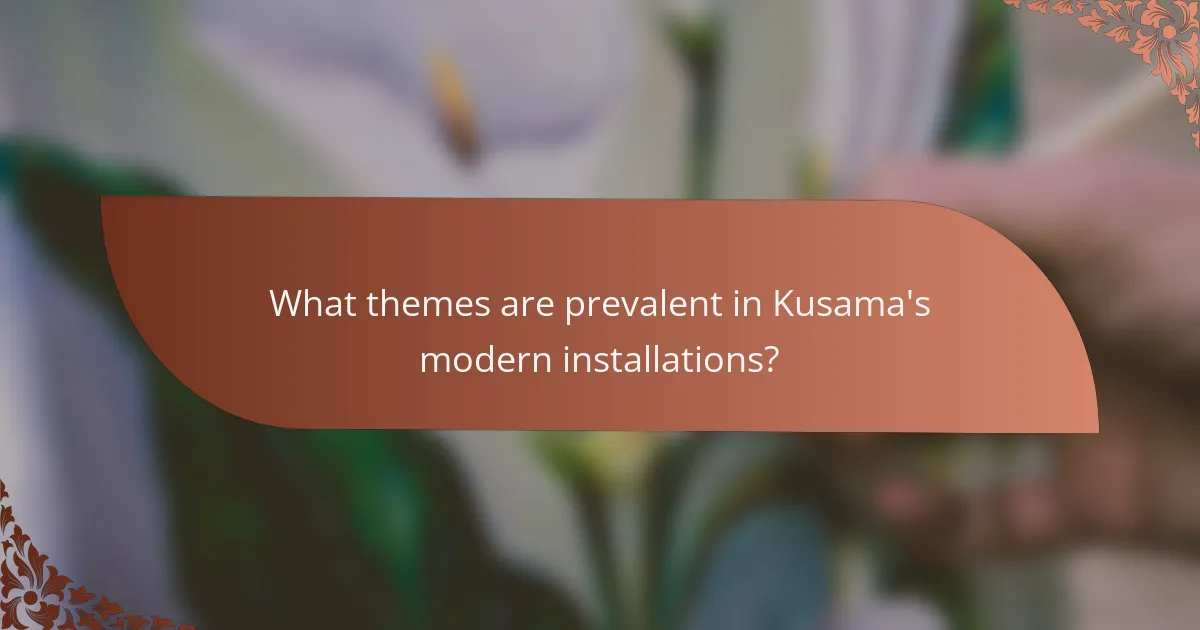
What themes are prevalent in Kusama’s modern installations?
Yayoi Kusama’s modern installations prominently feature themes of repetition and vibrant colour. Repetition symbolizes infinity and the cosmos, while bold colours evoke emotional responses. These elements create immersive experiences that invite viewers to engage deeply with her art. Kusama’s unique attribute is her use of polka dots, which often dominate her installations, reinforcing her themes of obsession and interconnectedness. Additionally, the rare use of mirrors in her work amplifies the sense of space and reflection, enhancing the viewer’s experience.
How does Kusama address mental health through her art?
Yayoi Kusama addresses mental health through her art by using repetition and vibrant colours to express her inner experiences. Her installations create immersive environments that invite viewers to engage with themes of obsession and anxiety. The polka dots and mirrored spaces symbolize her struggle with mental illness, transforming personal challenges into collective experiences. This approach fosters a sense of connection and understanding among audiences, emphasizing the therapeutic potential of art in mental health.
Which cultural influences shape her thematic choices?
Yayoi Kusama’s thematic choices are shaped by her experiences with mental health, Japanese culture, and the influence of the avant-garde art movement. Her use of repetition reflects her fascination with infinity and personal obsession, while vibrant colours draw from traditional Japanese aesthetics. Additionally, her works often challenge societal norms, emphasizing themes of identity and existence. These influences culminate in immersive installations that invite viewers to confront their own perceptions of reality.
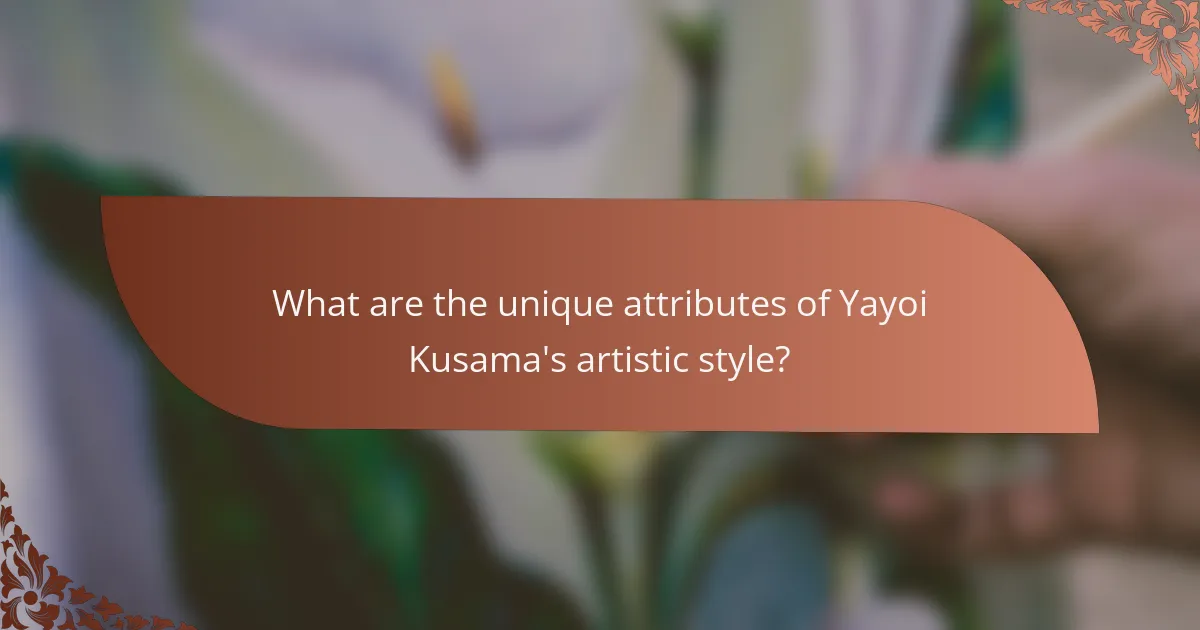
What are the unique attributes of Yayoi Kusama’s artistic style?
Yayoi Kusama’s artistic style is characterized by unique attributes such as immersive environments, polka dot patterns, and a focus on infinity. Her installations often utilize vibrant colours, creating a sense of depth and engagement. Kusama’s use of repetition serves as a reflection of her psychological experiences, making her work deeply personal and relatable. Additionally, her integration of sculpture and painting blurs traditional boundaries, showcasing her innovative approach to contemporary art.
How does her personal history inform her work?
Yayoi Kusama’s personal history profoundly influences her work, particularly her use of repetition and colour. Her experiences with mental health and childhood trauma shape her artistic expression, leading to immersive installations that reflect her internal struggles. The polka dots and repetitive patterns symbolize her obsession and desire for infinity, creating a unique visual language. Additionally, her time in New York during the 1960s introduced her to the avant-garde movement, further enriching her artistic approach. This blend of personal narrative and artistic exploration makes Kusama’s work distinctive and impactful.
What differentiates her installations from other contemporary artists?
Yayoi Kusama’s installations stand out due to her unique use of repetition and vibrant colour patterns. Her signature polka dots create immersive environments that challenge perceptions of space. Unlike other contemporary artists, Kusama’s work often reflects her personal experiences with mental health, adding depth to her art. This emotional connection differentiates her installations, making them both visually striking and profoundly impactful.
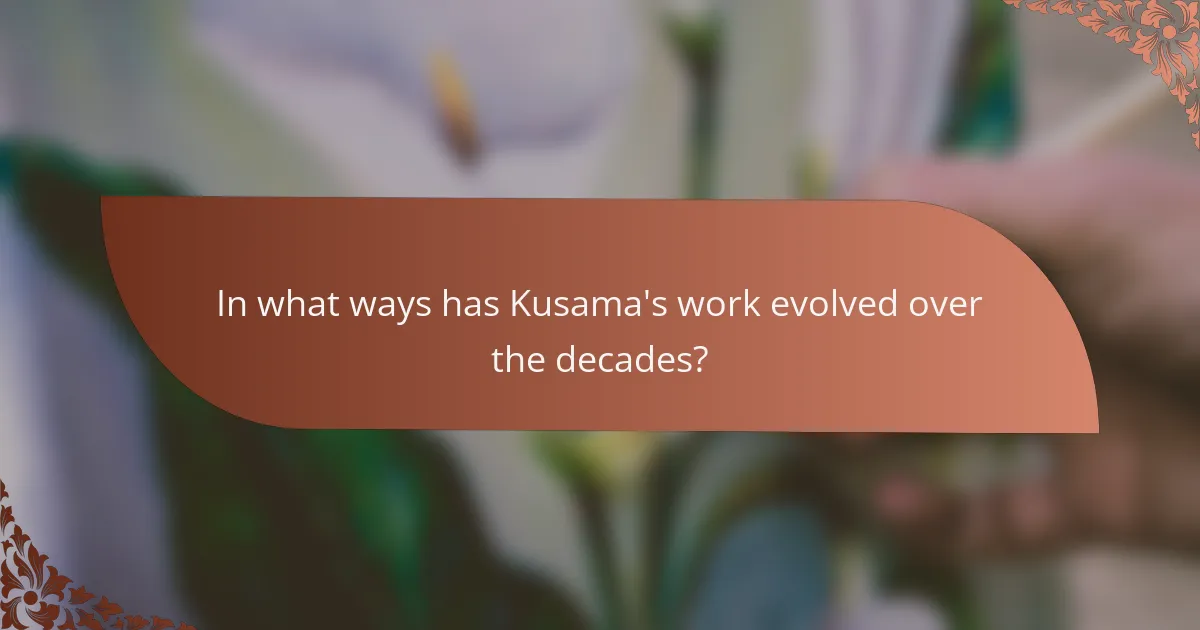
In what ways has Kusama’s work evolved over the decades?
Yayoi Kusama’s work has evolved through innovative use of repetition and colour, reflecting her unique vision. Initially focused on painting, she later embraced immersive installations that invite viewer interaction. Her signature polka dots and vibrant colours have transformed into large-scale installations, such as the Infinity Mirror Rooms, showcasing her exploration of infinity and self-obliteration. Over the decades, her art has integrated new media, including sculpture and performance, expanding her influence in contemporary art.
Which recent installations reflect her current artistic direction?
Yayoi Kusama’s recent installations showcase her ongoing exploration of repetition and colour. Notable examples include “Infinity Mirror Rooms,” which immerse viewers in kaleidoscopic reflections, and “Narcissus Garden,” featuring hundreds of reflective spheres. These works highlight her unique ability to engage audiences through immersive experiences and vibrant patterns. Her installations continue to evolve, emphasizing themes of infinity and self-identity.
How do her early works compare to her more recent pieces?
Yayoi Kusama’s early works feature simpler forms of repetition and colour, while her recent pieces exhibit more complex patterns and vibrant hues. Early works often focused on polka dots and basic shapes, emphasizing psychological themes. In contrast, recent installations incorporate immersive environments and interactive elements, showcasing her unique approach to infinity and self-obliteration. This evolution highlights her growing engagement with space and viewer interaction, reflecting a rare attribute of her artistic journey.
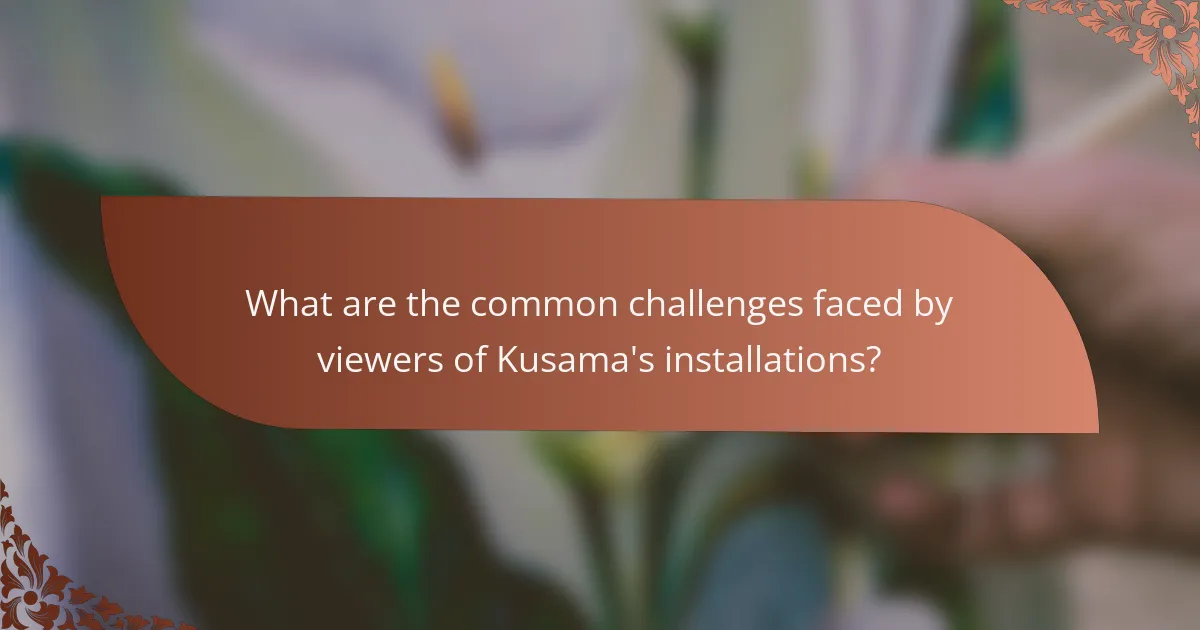
What are the common challenges faced by viewers of Kusama’s installations?
Viewers of Yayoi Kusama’s installations often face challenges related to sensory overload, disorientation, and emotional responses. The immersive nature of her work, characterized by repetition and vibrant colours, can overwhelm some visitors. Additionally, navigating crowded spaces within installations may lead to feelings of anxiety or discomfort. The abstract themes of infinity and obsession may also provoke introspection, which can be unsettling for certain individuals.
How can viewers engage more deeply with her art?
Viewers can engage more deeply with Yayoi Kusama’s art by immersing themselves in her themes of repetition and colour. Participating in interactive installations enhances personal connection. Engaging through social media by sharing experiences fosters community dialogue. Attending guided tours or workshops provides deeper insights into her artistic process. Collaborating on projects inspired by her work encourages creativity and exploration.
What misconceptions exist about her work?
Many misconceptions about Yayoi Kusama’s work focus on her use of repetition and colour. Some believe her art is merely about polka dots and bright hues, overlooking the deeper themes of infinity and self-obliteration. Others mistakenly view her installations as solely decorative, ignoring their commentary on mental health and personal experiences. Additionally, some assume her work is only relevant to contemporary art, while it actually draws from a rich history of artistic movements. These misunderstandings diminish the complexity and significance of her contributions to modern installations.
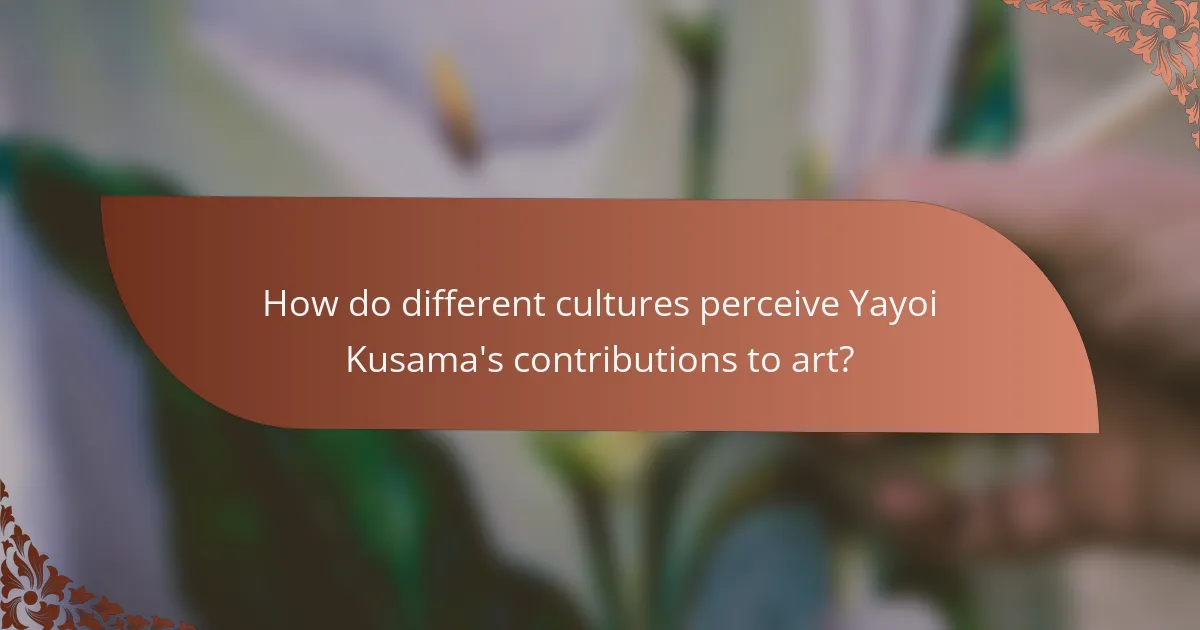
How do different cultures perceive Yayoi Kusama’s contributions to art?
Different cultures perceive Yayoi Kusama’s contributions to art as innovative and transformative, emphasizing her unique use of repetition and colour. In Japan, Kusama’s work reflects traditional aesthetics while challenging societal norms. Western audiences often celebrate her installations for their immersive experiences and emotional depth. Her polka dots and infinity rooms resonate globally, symbolizing themes of infinity and self-obliteration. Art critics highlight her impact on contemporary art movements, recognizing her as a pioneer in installation art. This cross-cultural appreciation underscores her role in bridging diverse artistic expressions.
What impact has her work had on the global art community?
Yayoi Kusama’s work has significantly influenced the global art community by popularizing immersive installations. Her use of repetition and vibrant colours challenges traditional art forms, fostering a new appreciation for experiential art. As a result, contemporary artists are increasingly inspired to explore similar themes. Kusama’s innovative approach has led to a broader acceptance of avant-garde practices, making her a pivotal figure in modern art.
Which exhibitions have significantly influenced her international recognition?
Yayoi Kusama gained international recognition through several influential exhibitions. Key shows include the “Infinity Mirror Rooms” at the Hirshhorn Museum in 2017, which showcased her signature immersive installations. The “Yayoi Kusama: Festival of Life” at the Tate Modern in 2012 expanded her global reach, emphasizing her innovative use of colour and repetition. Additionally, her participation in the Venice Biennale in 2013 significantly elevated her profile, highlighting her unique artistic vision. These exhibitions collectively contributed to her status as a leading figure in contemporary art.
What are the best practices for experiencing Kusama’s installations?
To experience Yayoi Kusama’s installations effectively, immerse yourself in the vibrant colours and repetitive patterns. Engage fully by taking your time in each space, allowing the art to resonate with your emotions. Visit during less crowded hours for a more intimate experience. Consider documenting your visit through photos or sketches, capturing your personal interpretation of the installations. Lastly, reflect on how Kusama’s unique use of repetition influences your perception of space and self.
